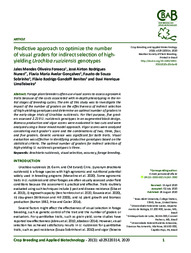Predictive approach to optimize the number of visual graders for indirect selection of highyielding Urochloa ruziziensis genotypes.
Predictive approach to optimize the number of visual graders for indirect selection of highyielding Urochloa ruziziensis genotypes.
Author(s): FONSECA, J. M. O.; NUNES, J. A. R.; GONÇALVES, F. M. A.; SOUZA SOBRINHO, F. de; BENITES, F. R. G.; TEIXEIRA, D. H. L.
Summary: Forage plant breeders often use visual scores to assess agronomic traits because of the costs associated with in-depth phenotyping in the initial stages of breeding cycles. The aim of this study was to investigate the impact of the number of graders on the effectiveness of indirect selection of high-yielding genotypes and determine an optimal number of graders in the early-stage trials of Urochloa ruziziensis. For that purpose, five graders assessed 2.219 U. ruziziensis genotypes in an augmented block design. Biomass production and vigor scores were evaluated in two cuts and were analyzed using a linear mixed model approach. Vigor scores were analyzed considering each grader?s score and the combinations of two, three, four, and five graders. Genetic variance was significant for both traits. Visual evaluation was effective in identifying productive genotypes based on the statistical criteria. The optimal number of graders for indirect selection of high-yielding U. ruziziensis genotypes is three.
Publication year: 2020
Types of publication: Journal article
Unit: Embrapa Dairy Cattle
Keywords: Accuracy, Brachiaria, Capim Brachiaria, Forage breeding, Forragem, Melhoramento, Precisão, Visual selection
Observation
Some of Embrapa's publications are published as ePub files. To read them, use or download one of the following free software options to your computer or mobile device. Android: Google Play Books; IOS: iBooks; Windows and Linux: Calibre.
Access other publications
Access the Agricultural Research Database (BDPA) to consult Embrapa's full library collection and records.
Visit Embrapa Bookstore to purchase books and other publications sold by Embrapa.

